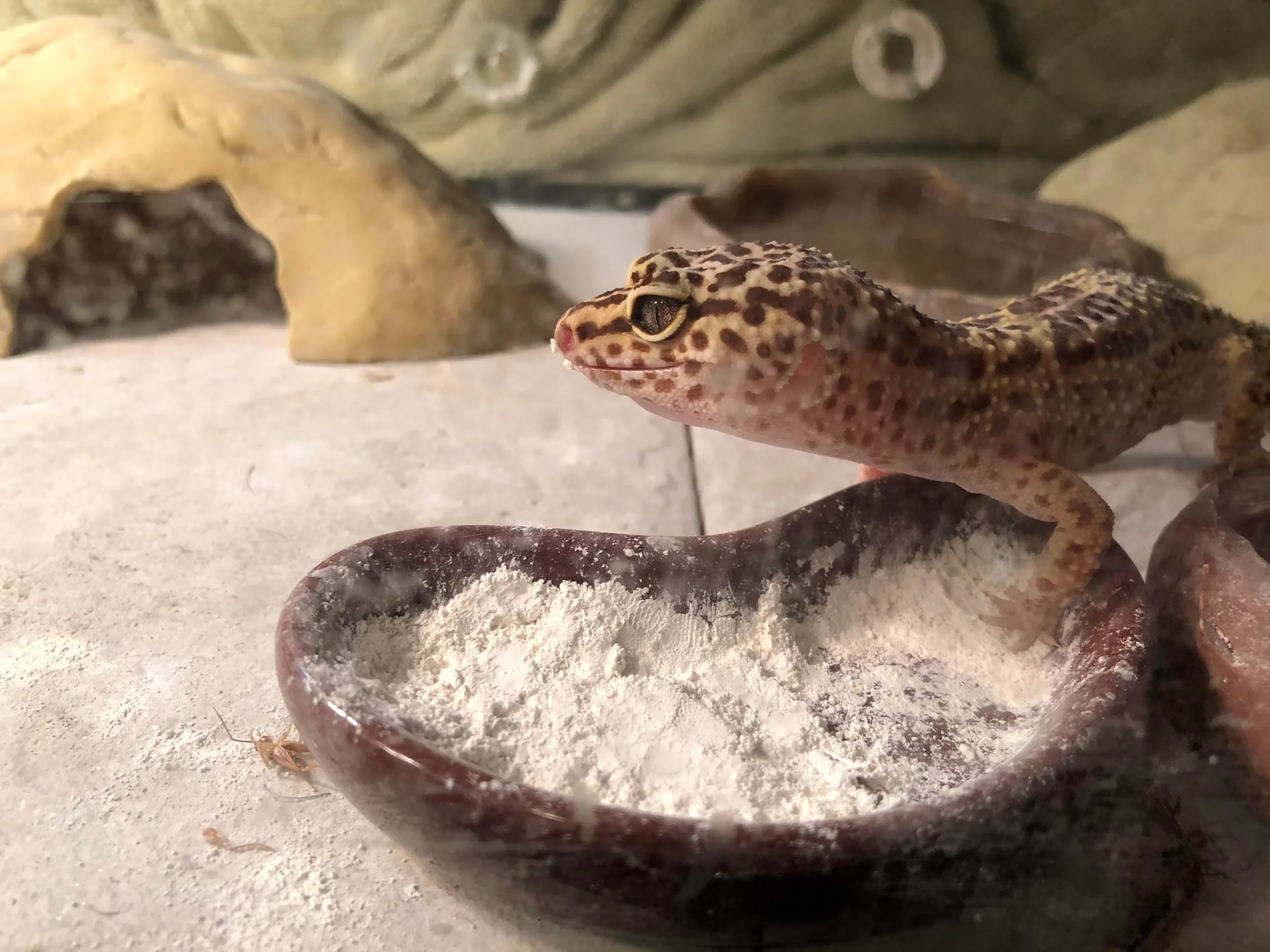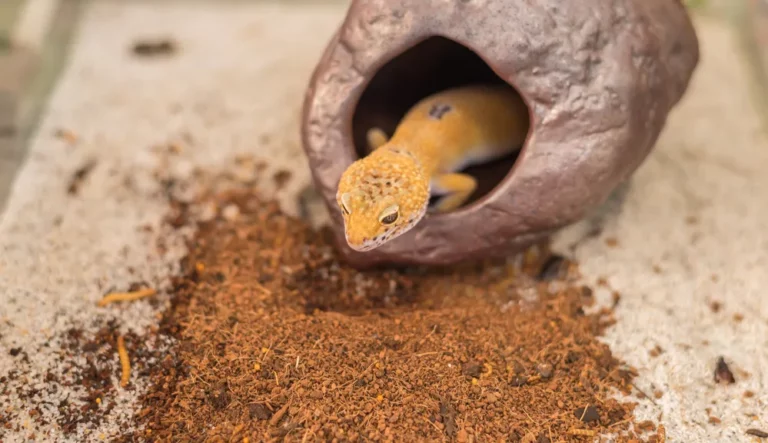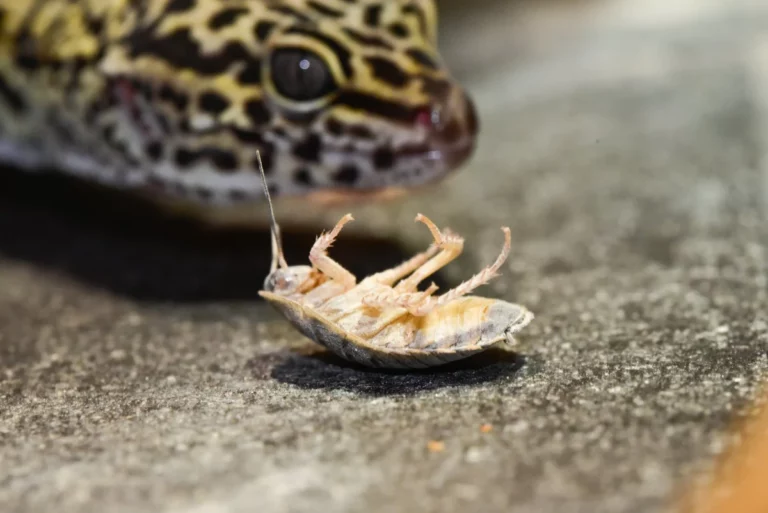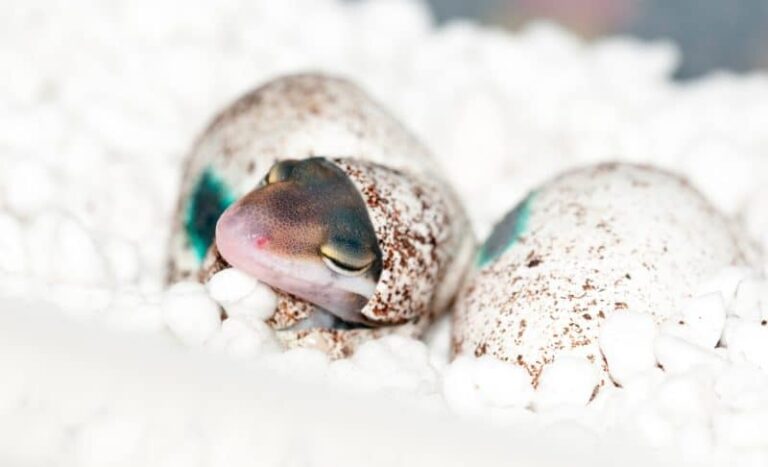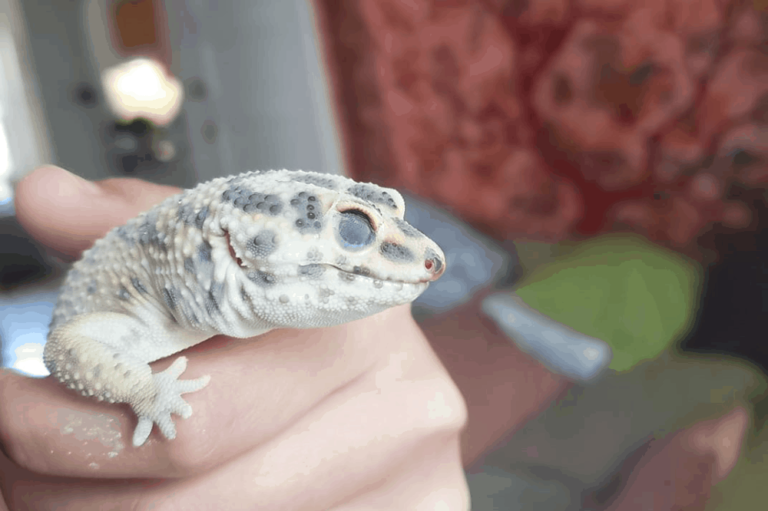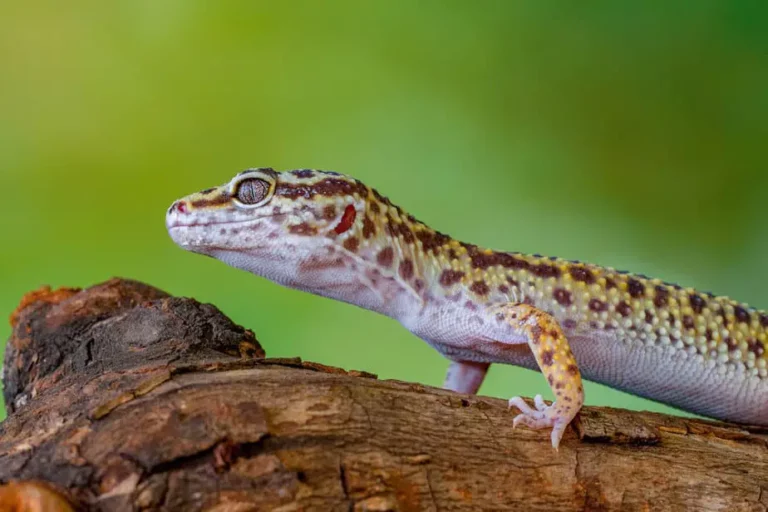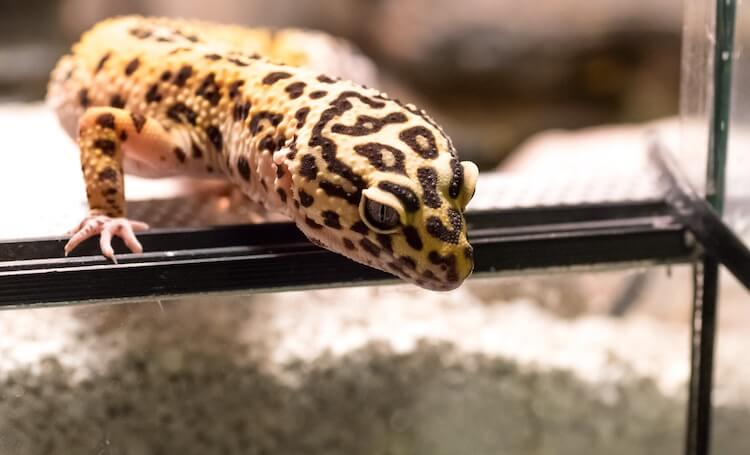How Often Should I Feed My Leopard Gecko Calcium? The Essential Guide
As I peered into the glass terrarium, my heart swelled with affection for my petite, spotted companion, Spike. With his vibrant orange hues and mesmerizing eyes, it was hard not to be captivated by his beauty.
However, owning a leopard gecko-like Spike came with its own set of responsibilities, and one question that often crossed my mind was, “How often should I feed my leopard gecko calcium?”
Despite their small stature, they require meticulous care to thrive, and ensuring they receive the right amount of calcium is a crucial part of their diet.
- Baby geckos: daily with 3 times a week and a weekly multivitamin.
- Young geckos: 5 times a week with calcium once a week and a weekly multivitamin.
- Adults: every other day with calcium once a week and a monthly multivitamin.
- Breeding females: every other day, calcium 3 times a week, and a weekly multivitamin.
Whether you’re a new owner or just curious, let’s explore the world of these lovely creatures together and make sure they get the calcium they need.
Top Products For Calcium
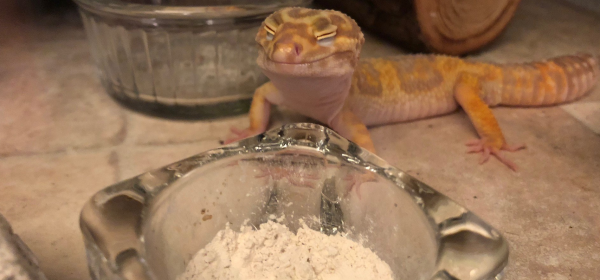
- It is a high-quality, finely ground plain calcium powder.
- Also, it’s suitable for daily use and provides 100% natural calcium.
- Comes with easy-to-follow instructions for dosing based on your leopard gecko’s size and age.
Repashy Super Foods Calcium Plus:
- In addition, it is an all-in-one calcium powder designed for dusting insects before feeding.
- It contains 17% calcium and generous amounts of essential vitamins (A, D, and E).
- The fine micro-ground texture adheres well to insects, making it an efficient choice.
Zoo Med Repti Calcium with Vitamin D3:
- It is a calcium carbonate source with high bioavailability.
- Formulated to enhance calcium absorption, it’s ultra-fine and free from phosphorus and impurities.
- Contains safe amounts of vitamin D3 to support calcium utilization.
- Meric offers a highly-rated calcium supplement with an ideal calcium-to-phosphorus ratio of 2:1.
- Designed for free lick consumption, it’s appealing to leopard geckos.
- It doesn’t contain vitamin D3 to prevent overdosing, allowing you to combine it with a separate vitamin D3 supplement as needed.
- Provides excellent value with a long-lasting supply.
- Sepia bones, also known as cuttlebones, are derived from cuttlefish and are a natural source of calcium carbonate.
- They are hard but brittle and can be crushed or turned into powder for feeding to them.
- You can purchase ready-to-consume sepia bone powder or make your own by collecting cuttle shells, cleaning them, drying them, and breaking them into smaller pieces or grinding them into powder
- While not solely a calcium supplement, Herptivite is a comprehensive multivitamin powder that includes calcium.
- It provides a wide range of essential vitamins and minerals for overall reptile health.
- Further, can be used in combination with other calcium supplements to ensure a balanced diet.
JurassiCal Calcium Supplement:
- Lastly, It is a pure calcium carbonate powder without added phosphorus.
- It’s an excellent choice for supplementing calcium without altering the phosphorus-to-calcium ratio in diet.
- You can dust feeder insects or mix them with other adjunct as needed.
How Often Should Feed Leopard Gecko Calcium And Viamind: Quick Schedule
| Age/Stage | Feeding Frequency | Calcium (Ca) | Calcium + Vitamin D3 (Ca + D3) | Multivitamin | Additional Pure Calcium Dish |
| Babies | Daily with gut-loaded insects 5-7 small crickets/mealworms daily | 3 times a week | – | Once a week | Not required |
| Juveniles | Approximately 5 days a week | 1 time a week | 2 times a week | Once a week | Not required |
| Mature Adults | Every alternate day or 3-4 days a week/ 6-7 large insects | 1 time a week | 2 times a week | Once a month | Periodically in the evenings |
| Breeding Females | Every alternate day | 3 times a week | – | Once a week | Offered for self-regulation |
Additional Feeding Guidelines:
- Feed in the evening, around sundown, to mimic their natural foraging behavior.
- Insects should be no larger than the space between your gecko’s eyes to prevent choking.
- Rotate staple insects like crickets, locusts, and roaches for a balanced diet.
- Use mealworms and waxworms as occasional treats due to their high fat content.
- Do not leave live insects in the enclosure; they can cause stress to your pet.
- Use a feeding dish with smooth, rounded sides to prevent escapes.
- Remove uneaten insects after 15 minutes or feed them by hand.
- Gut-load insects with a diet of dark leafy greens, carrots, apples, potatoes, squash, oats, and commercial cricket food.
- Also, gut-load insects 12-24 hours before feeding to ensure they absorb vital nutrients.
- Commercial cricket foods like Repashy Superload Insect Gutload Formula provide essential nutrients.
- Provide fresh, clean water daily in a shallow dish to prevent drowning; tap water is safe and contains beneficial minerals.
Why Do Leopard Geckos Need Calcium?
Bone Strength and Regeneration: Calcium is the cornerstone for the formation and maintenance of a leopard gecko’s skeletal structure. It is especially critical during the growth phases of baby and juvenile, as well as in adulthood to uphold bone integrity.
Remarkably, calcium is indispensable for geckos’ regenerative abilities, including the regrowth of body parts such as their tail and even their heart, making it an essential nutrient for their remarkable resilience.
Dental Health: They constantly replace their teeth, and they have an impressive 100 teeth that renew every 3-4 months. To support this continuous dental turnover and maintain strong teeth, rely on a steady supply of calcium.
Prevention of Metabolic Bone Disease (MBD): MBD is a severe and debilitating condition that affects the skeletal structure of leopard geckos. It encompasses conditions like osteoporosis, osteodystrophy, and hyperparathyroidism.
Moreover, MBD arises from an imbalance of calcium, phosphorus, and vitamin D3. Its effects extend beyond the bones, impacting overall bodily functions. Recognizable signs of this include leg deformities, lethargy, softening of jawbones, and appetite loss. This condition can be fatal if left unchecked, underlining the critical role of calcium in maintaining skeletal health.
Enhanced Egg Production: Breeding female have heightened calcium demands due to the frequent production of eggs. It is a primary component of eggshells, and females can lay multiple clutches of eggs during the breeding season. Ensuring that she receive increased intake is vital to compensate for the substantial calcium depletion incurred through egg production.
Nerve Function: Additionally, vital for the transmission of nerve signals throughout the body. Nerves use calcium ions to generate electrical signals, which control muscle contractions and regulate bodily functions.
Blood Clotting: Also, involved in the blood clotting process. Without sufficient calcium, they may experience difficulty in clotting blood properly, which can be life-threatening if they are injured.
Enzyme Activation: Many enzymes in the body require calcium ions as cofactors to function correctly. Enzymes are essential for various metabolic processes, including digestion and energy production.
Choosing the Right Calcium Supplement Leopard Gecko
Age and Breeding Status: The calcium and vitamin D3 needs of your leopard gecko can vary with age and whether they are breeding. Young geckos, like hatchlings and juveniles, require more due to their growth. Breeding females also have increased demands because of egg production.
Calcium-to-Phosphorus Ratio: Check for a supplement that maintains the ideal calcium-to-phosphorus ratio of 2:1. This balance is crucial for supporting their metabolic functions and preventing issues like metabolic bone disease (MBD).
Feeder Insects: Take into account the phosphorus content in primary feeder insects. Most feeder insects naturally have low calcium and high phosphorus levels, which can impede absorption. If your gecko’s diet mainly consists of these insects, it’s even more vital to provide a calcium supplement to counteract the phosphorus imbalance.
Research and Compare Products: Conduct thorough research on different adjuncts, both online and in local reptile stores. Compare their content, vitamin D3 levels, and any additional nutrients they offer. Look for products specifically designed for reptiles.
Vitamin D3 Balance: While vitamin D3 is essential for, excessive amounts can be detrimental. Seek supplements with safe and appropriate vitamin D3 levels. Remember that an overdose of can have adverse effects.
Quick Checklist Of Food For Leopard Gecko Calcium Source:
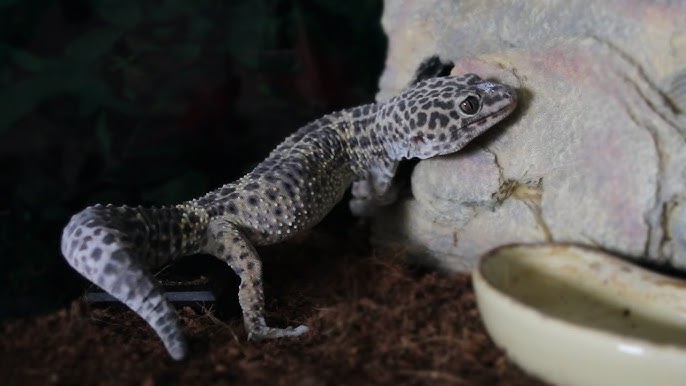
Feeder Insects:
- Crickets
- Dubia Roaches
- Phoenix Worms (Black Soldier Fly Larvae)
- Mealworms
- Superworms
Commercial Insect Gut-Load Products:
- Cricket Gut-Load
- Roach Gut-Load
- Worm Gut-Load
Calcium Supplements:
- Calcium Powder
- Calcium with Vitamin D3 Powder
Calcium-Rich Vegetables and Greens for Gut-Loading Insects:
- Dark, leafy greens such as collard greens, dandelion greens, and mustard greens.
- Vegetables like carrots, sweet potatoes, and squash.
FAQs
Can a Leopard Gecko survive without calcium?
– No, calcium is essential for their health.
How has captivity altered things?
– In captivity, they have more consistent access to calcium.
How Often Should I Change My Leopard Gecko’s Calcium Dish?
– Every 2-3 days is recommended.
Should You Worry If Your Leopard Gecko Doesn’t Have A Calcium Dish In Their Enclosure?
Yes, as it’s crucial for their well-being.
Can Leopard Geckos Get Too Much Calcium?
– Yes, excess calcium can lead to health issues.
When to Replace Calcium in Calcium Bowl?
– Replace it when it’s empty or every 2-3 days.
Final Words
In summary, making sure my leopard gecko gets enough calcium is really important for its health. How often I give it calcium depends on its age. When it’s a baby, it needs calcium more often because it’s growing fast. As it becomes an adult, I can give it calcium less often, but it still needs some to stay healthy and avoid problems like metabolic bone disease.
I also need to think about the kind of insects I feed because some have more phosphorus, which can make it harder for the gecko to use the calcium. If my gecko is a breeding female, it needs even more calcium because of the eggs it’s making.
The main thing to remember is that I should adjust the calcium schedule based on my gecko’s age and keep an eye on its health. If I’m not sure, I can always ask a reptile veterinarian for advice. This way, I can make sure my gecko stays healthy and happy.

